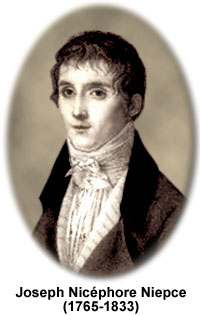Joseph Nicéphore Niepce
(1765-1833)

Joseph Nicéphore Niepce was a French researcher who is most famous for producing the first known photograph. Born on March 7, 1765 to a moderately wealthy family, Niepce pursued a variety of careers, including teaching and military service. However, around 1795 he settled on his family estate in Chalon-sur-Saône, France to concentrate of research and experimentation with his brother Claude.
The brothers explored a variety of fields, but were primarily concerned with building a combustion engine that could be used with boats. Moderately successful, they patented their invention known as the pyreolophore in 1807. The device utilized a piston-and-cylinder system and initially used lycopodium powder for fuel. The pair hoped to eventually make a profit from their invention and spent much of their time attempting to improve upon it. Eventually, Claude moved to London, England in hopes of finding a successful way to exploit the engine, while Niepce remained in France.
Around 1813, Niepce became involved in another pursuit, which was spurred by the increasing popularity of the art of lithography. Extremely innovative, Niepce developed a slightly different process that he called heliography, in which he placed transparent engravings on plates coated in a light sensitive varnish that he had composed. However, as an inferior artist, Niepce wanted to further alter the process in such a way that engravings were not necessary. To do so, he combined use of the camera obscura and silver salts, which were known to darken when exposed to sunlight, and first endeavored to produce a photograph in 1816. Though he successfully captured a rough image, it faded away shortly thereafter.
For the next ten years Niepce continued his experiments, seeking a way to make a photographic image permanent. Finally, on a bright summer day in 1826, Niepce created the first permanently fixed photographic image, a view of his courtyard fixed upon a pewter plate. Exposure of the image took approximately eight hours and, therefore, Niepce realized that further advances needed to occur before the process could be commercialized. Thus, though he was initially hesitant, in 1829 he formed a partnership with Louis-Jacques-Mandé Daguerre in hopes of more expediently perfecting the technique.
Nevertheless, when Niepce died of a stroke in 1833 he had not yet attained the recognition or financial success he desired. Daguerre, however, continued modifying Niepce's photographic technique, releasing the daguerreotype in 1839. The new form of photography quickly grew in popularity and Daguerre soon overshadowed Niepce. Nevertheless, without Niepce's pioneering efforts, Daguerre may never have triumphed, forever altering the history of photography.
